Abstract: This article summarises a study into the egg-laying habits of the Small Copper (Lycaena phlaeas) on Common Sorrel (Rumex acetosa) and Sheep's Sorrel (Rumex acetosella) in my garden in west Somerset, undertaken as part of the Extended Project Qualification, alongside my AS levels. A survey of egg-laying was used to test the hypothesis that female Small Coppers would prefer to oviposit on shorter Sorrels that were regenerating after grazing, in the hope that the project's findings would enable me to provide more of such Sorrels (thereby encouraging further breeding in my garden) and potentially inform habitat management for this species on a broader scale. It was found that relatively short plants, with relatively small leaves, growing in short grass were preferred, and with these variables being taken as indicators of grazing, I accepted my aforementioned hypothesis.
Many of the British butterfly species, so long a staple of walks in the countryside, providing memories of heady summer days in the garden and childhood exploration, are in serious decline. Indeed, 10 year trends show that the distributions of 54% of species of butterfly in the British Isles have declined, making them one of our most threatened groups of wildlife (Fox et al., 2011).
As an AS Biology student, hoping to carry on with the subject at University with a view to becoming an Ecologist, I was keen to carry out a practical field study on some part of the natural world during my project, enabling me to learn more about a scientific approach to problem-solving.
Knowing of the precipitous declines of many of my favourite butterfly species, I decided to study them, in the hope that, even on a relatively inexperienced level, I might find something useful to contribute. At the same time, by a happy co-incidence, I found that Small Coppers were breeding in my garden and the decision was made to study them and, in particular, determine which Sorrels they preferred to lay their eggs on. By discovering what kind of plants Small Coppers prefer to lay on, I hoped to create better habitat for them in my garden, as selected oviposition sites provide a good indication of best quality habitat for a given species (Fartmann, 2005; Gilbert and Singer, 1975).
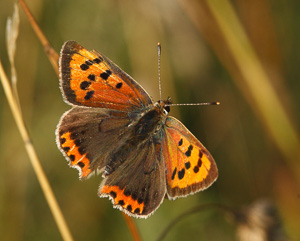 |
| Figure 1 - A male Small Copper Image © William Langdon |
The Small Copper, Lycaena phlaeas Linnaeus, 1761 (UK Butterflies, 2015), is a brightly-coloured butterfly (see Figure 1) with a distribution encompassing Europe, temperate Asia, North Eastern North America, and North and East Central Africa (Tolman and Lewington, 2008). It belongs to the family Lycaenidae (gossamer-winged butterflies). In Europe this family also contains the Blues and Hairstreaks (Tolman and Lewington, 2008).
In mainland Britain, the subspecies eleus flies, and was originally described by Fabricius in 1798 (UK Butterflies, 2015). This is the subspecies I am studying in my garden. In the UK, Small Coppers are typically trivoltine, with a first brood flying from May to early June, a second from mid-July to early September, and a third from late September to early November (Tolman and Lewington, 2008; UK Butterflies, 2015; Thomas and Lewington, 2010), with the third brood being markedly smaller in number than the preceding two and often merging into the second. It is this merged second/third brood that I intended to study.
The Small Copper lays its eggs either on Common Sorrel (Rumex acetosa) or Sheep's Sorrel (Rumex acetosella) and occasionally Broad-Leaved Dock (Rumex obtusifolius) (UK Butterflies, 2015). The latter is thought to be used in the absence of suitable Sorrels (Thomas and Lewington, 2010).
Both species of Sorrel are common throughout the areas in which the Small Copper flies (Streeter et al., 2009), accounting for the widespread nature of this species. Like Docks, Sorrels are deep-rooted and persistent, but also have a high seed germination rate, allowing them, and consequently the Small Copper, to take advantage of recently disturbed areas.
When egg-laying, a female will fly low over the vegetation, settling frequently, not always on Sorrels (Dempster, 1971) and crawl through the sward in search of foodplants, testing their suitability with her antennae (Thomas and Lewington, 2010). When a suitable egg-laying site is found, the female will curl her abdomen round and deposit a single egg, typically on the upperside of the leaf, along or close to the midrib. The egg (see Figure 2) is white in colour and its casing, with a protective chorion membrane (Brooks and Knight, 1982), has a pitted appearance reminiscent of a golf -ball or one of the legendary Eden Project Biomes.
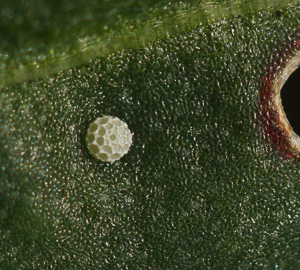 |
| Figure 2 - A Small Copper Ovum Image © William Langdon |
Eggs normally hatch after one or two weeks (Thomas and Lewington, 2010), depending on external conditions, and the young larva (see Figure 3) quickly moves to the underside of the leaf to begin feeding. In doing so, it strips away the lower epidermis of the leaf, leaving distinctive transparent grooves in which it rests, making it easy to detect (see Figure 4) (Thomas and Lewington, 2010;. UK Butterflies, 2015).
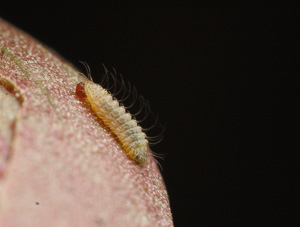 | 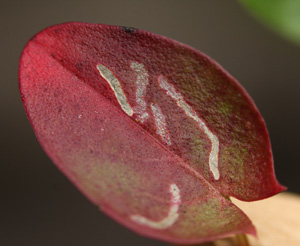 |
| Figure 3 - A young Small Copper larva Image © William Langdon | Figure 4 - The distinctive feeding damage of the young Small Copper larva Image © William Langdon |
The slug-like larvae vary in colour, being either pure green, or green with heavy purple-pink markings (see Figure 5). Those resulting from the eggs of the first brood grow quickly, eating larger portions of the leaves as they do so, before pupating after about a month, whilst those from the eggs of the second and third brood stop feeding in their third instar (normally during October), and become dormant through the winter months (Dempster, 1971).
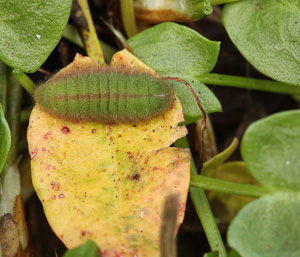 |
| Figure 5 - A mature Small Copper larva Image © William Langdon |
After emerging in the spring the overwintered larvae recommence feeding, before pupating during April (UK Butterflies, 2015), and emerging after 2 to 3 weeks. The pupa itself is a fairly nondescript speckled brown (see Figure 6) and is very rarely found in the wild, though it is thought that it forms some kind of association with ants (Thomas and Lewington, 2010), like most Lycaenids.
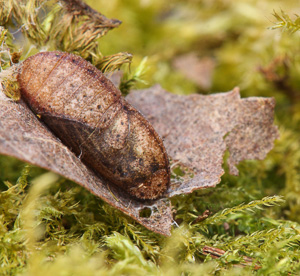 |
| Figure 6 - A Small Copper pupa Image © William Langdon |
Imagines are relatively short-lived, and tend to exist at low densities in a variety of habitats where the foodplants grow, including grassland, heathland, road and track verges, brownfield sites and disturbed areas such as recently felled woodland (UK Butterflies, 2015).
Males are well known for being extremely territorial and will typically monitor their domain from a favoured perch and vigorously defend it against all-comers, from rival males, to other species of butterfly. Females live a more sedate life. Mating soon after emergence,; much of their time is spent searching for suitable egg-laying sites, often crawling through vegetation in a way that makes them quite inconspicuous.
The selection of egg-laying sites is an important decision for female butterflies, as the situation and quality of the foodplant has important consequences for larval development and survival, given the relative immobility of young lepidopteran larvae (Rabasa et al., 2005). Jeremy Thomas (2010) describes the female Small Copper as extremely fussy when egg-laying, only choosing the most desirable plants for oviposition.
Clearly then, there are a number of factors that she takes into account when selecting egg-laying sites, the first of which is temperature.
Butterfly larvae are ectotherms, requiring external sources of heat to remain active. Studies have been done by Turlure and Van Dyck (2009) on the effect of foodplant microclimate on one of the Small Copper's relatives, the Purple-Edged Copper (Lycaena hippothoe). It was found that females preferred warmer, more isolated plants. This higher temperature around the foodplant accelerated egg-hatching and the development of larvae, and resulted in larger larvae at diapause, suggesting that temperature is a vital factor in larval development and fitness. The brood of Small Coppers that I studied is the merged second and third, and the resultant larvae do go into diapause. A large size at this stage could definitely increase the survival of the larvae over the winter (they do not have to break diapause and feed, making themselves more vulnerable to predation) and so temperature could be an important factor in the egg-laying of these particular Small Coppers.
Another variable to consider in oviposition site selection is the foodplant's quality: how nutritious it is. A vital element for the formation of proteins, enacting metabolic processes and genetic coding and therefore an essential one for larval growth, is Nitrogen (Mattson, 1980). Indeed, Thomas (2010) suggests that during the 2nd and 3rd broods, egg-laying Small Coppers prefer smaller, younger Sorrels that are regenerating after grazing or disturbance, hypothesising that their new growth is richer in Nitrogen. The work of Mattson (1980) on plant Nitrogen content found that the highest concentrations of plant Nitrogen do indeed occur in the young, growing tissues (typically 3%-7% dry mass), tailing off when the tissues mature and stop growing. Furthermore, it was found that defoliation (as a result of grazing for example) is consistently followed by an increase in Nitrogen levels, so disturbed or grazed plants that are regenerating would have a doubly high Nitrogen level, and be doubly suitable for Small Copper eggs and larvae. This theory of a preference among Coppers for smaller plants that are richer in Nitrogen is borne out in a study by Eric Duffey (1968) on one of the Small Copper's relatives, the Large Copper (Lycaena dispar), which found that this species preferred to lay on smaller Water Docks (Rumex hydrolapathum) with fewer leaves, though there is no speculation in this study as to the relative Nitrogen richness of these plants.
Despite this weight of opinion and evidence behind Coppers preferring smaller, Nitrogen-rich plants, a study on another species closely related to the Small Copper, the Sooty Copper (Lycaena tityrus), by Fischer and Fiedler (2000), found that females were in fact unable to differentiate between plants containing different levels of Nitrogen, and that larvae that fed on plants high in Nitrogen had significantly higher mortality (73% on Nitrogen-rich plants, and 33.3% on Nitrogen-poor plants). Despite this, said larvae did grow much faster, a factor that could be important in the 2nd and 3rd brood Small Copper larvae that I studied since their body mass is sufficient to overwinter without breaking diapause.
In the end, I decided to test the hypothesis:
Small Coppers will prefer to lay eggs on smaller Sorrels that are regenerating after grazing.
For my study area, I chose a portion of a field adjacent to my garden, a 15.5m x 5m grassland plot (77.5m²) (see Figure 7). The flora of the study site is fairly typical for unfertilised, but agricultural-type, grassland in West Somerset, with a sward largely dominated by grasses including Cocksfoot (Dactylis glomerata), Yorkshire Fog (Holcus lanatus) and Sweet Vernal Grass (Anthoxanthum odoratum). Various common wildflower species grow here also, including Creeping Buttercup (Rannunculus repens), Red Clover (Trifolium pratense), Black Medick (Medicago lupulina), White Clover (Trifolium repens), Yarrow (Achillea millefolium), Ribwort Plantain (Plantago lanceolata) and Hawkweeds (Hieracium spp.) These flowers and grasses form quite a dense sward, though frequent disturbance by Rabbits (Oryctolagus cunniculus) creates bare patches, which Sorrels often colonise. Regular grazing by Rabbits and a small flock of Sheep (periodically introduced to the field of which the study site is a part) keeps grass growth in check, preventing the more tender plants, like Sorrels, being out-competed. The study site lies upon a sandstone substrate and faces southwards, the lower part being fairly flat, before rising sharply. Both Common Sorrel and Sheep's Sorrel grow at high densities in the study site and, although it does not have a resident colony of Small Coppers, females of the 2nd and 3rd brood visit regularly during August and September, laying large numbers of eggs in and around the site.
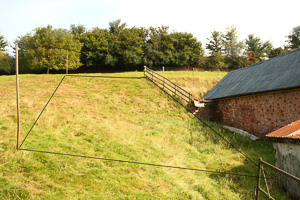 |
| Figure 7 - My study site with its boundary shown in black Image © William Langdon |
A pilot study was carried out in the weeks leading up to the survey, with the study site kept under close observation, to note Small Copper activity, in order to see whether enough eggs would be laid to give me a large enough sample size to make the study viable, and to note how the Sorrels on the site grew, informing me as to what variables I should measure to assess their development and test my hypothesis.
During this pilot study, I noted several Small Coppers on the wing, the large majority of which were females, and decided that the survey would indeed prove productive. The survey was carried out on the 28th September 2014, when the 2nd brood of Small Coppers had finished flying and laying eggs.
The study area was divided up into squares 0.5m x 0.5m in size, as a means of breaking it down for easy surveying. Each square was then systematically sampled in order to survey all the Sorrels in the study site (a total of 101 plants) and then, for each plant, several variables were measured as follows:
As shown in Figure 8, female Small Coppers have a clear preference for plants with smaller leaves, with 75% of plants with leaves of length between 0.5cm and 1.0cm receiving eggs (often several eggs), significantly more than those of other categories, in which no more than 30% of plants received eggs.
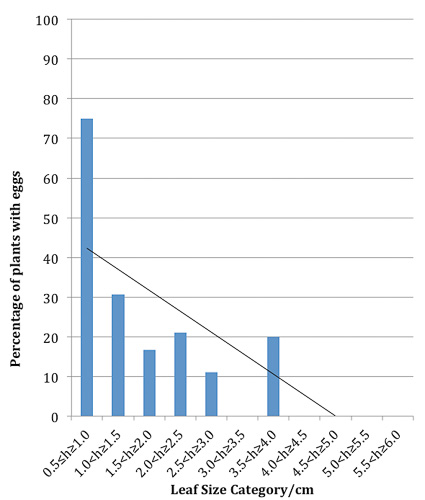 |
| Figure 8 - Percentage of Sorrel plants of different leaf sizes with Small Copper eggs |
The Product Moment Correlation Coefficient (or r value) for these data and all other data sets demonstrates the strength of correlation between the two variables.
For this data set, r = -0.6089. Generally speaking, an r value of r < -0.7 can be said to indicate a strong negative correlation (Fasham, 2014, pers. comms, October) but in ecology, where external variables can be at work that are very difficult to control in the context of a field study, allowances can be made and it can be said that there is a fairly strong negative correlation between leaf size and the percentage of plants with Small Copper eggs. i.e. the suitability of Sorrels for egg deposition declines as their size increases. Clearly, females prefer plants with smaller leaf sizes, the optimum being those with the smallest leaves, of 0.5cm < h ≥ 1.0cm, upon which significantly more eggs were laid than other plants.
A clear preference is shown in female Small Coppers for Sorrels in a shorter sward height, with all eggs laid on Sorrels shorter than 6cm. It can also be seen that the number of eggs tends to decrease as grass height increases. This is supported by the r value of -0.5061, showing a negative correlation between the two variables.
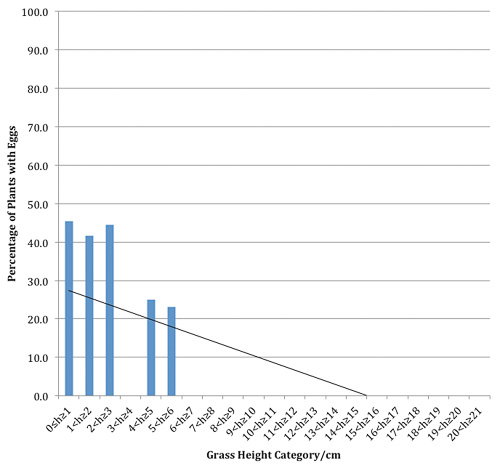 |
| Figure 9 - Percentage of Sorrels in a certain grass height with Small Copper eggs |
An r value of -0.6789 demonstrates a strong negative correlation between height in Sorrels and the percentage of plants receiving eggs from Small Coppers, as shown here. This suggests that as a Sorrel's height increases, its suitability for oviposition declines.
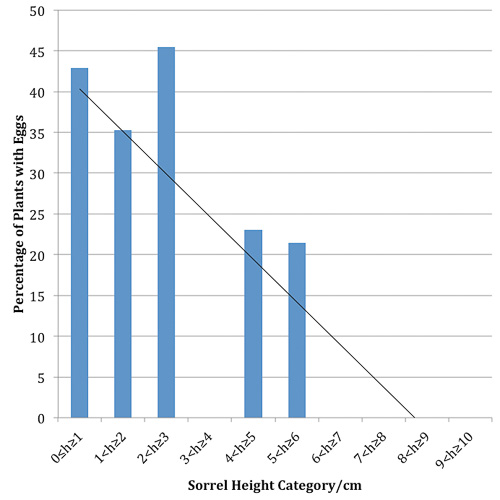 |
| Figure 10 - Percentage of Sorrels of certain heights with Small Copper eggs |
Indeed, a clear bias for shorter plants is shown, with 42.8% of plants 0cm < h ≥ 1cm, 35.2% of plants 1 < h ≥ 2cm and 45.5% of plants 2cm < h ≥ 3cm receiving eggs. This is significantly more than plants of other categories, and demonstrates that female Small Coppers prefer shorter Sorrels for oviposition.
From the above data, it can be concluded that:
Female Small Coppers prefer shorter Sorrel plants (below 6cm) in a short sward (below 6cm), with smaller leaves (generally below 2cm, but up to 4cm) for oviposition.
I have found that female Small Coppers prefer shorter plants in a shorter sward (below 6cm in both cases). It is clear that shorter plants in a shorter sward must have been grazed in order to shorten them (in a normal growing season, Sorrels and the grasses present in the study area would grow much taller), and so it can further be said from my findings that female Small Coppers prefer Sorrels that have been grazed, making the plants suitable for oviposition.
It was also found that the butterflies preferred Sorrels with smaller leaves. This initially would appear to be a factor independent of grazing, but further inspection reveals this not to be the case; as can be seen in Figure 11, there is a clear relationship between Sorrel leaf size and grass height, where r = 0.9144. Since r > 0.7 can be said to indicate a strong positive correlation (Fasham, 2014, pers. comms, October), there is a very strong positive correlation between the two variables.
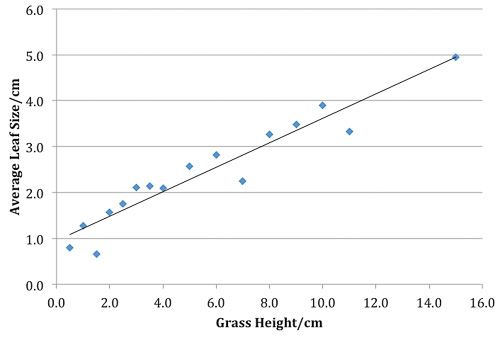 |
| Figure 11 - How Grass Height affects Sorrel Leaf Size |
This shows that a small leaf size is probably caused by the grazing on the study site by Rabbits and Sheep that also results in a short grass height. So, if Small Coppers prefer plants with smaller leaves, they do in fact prefer plants that have been grazed, and so my findings can be condensed down to:
For oviposition, female Small Coppers prefer Sorrel plants that have been grazed.
But why? Plants that have been grazed will regenerate from their grazing and put on new growth in order to photosynthesise, produce energy and grow. This new growth is much richer in Nitrogen than normal plant material (Mattson, 1980), an element which is extremely important for the growth of Small Copper larvae (Mattson, 1980; Joern and Behmer, 1997). Indeed, when present at increased levels, Nitrogen would enable the larvae to grow more quickly (Fischer and Fiedler, 2000). In the case of the second/third brood of Small Copper larvae that I studied, the larvae must become dormant and go through diapause over the winter, and faster growth will enable them to reach a larger size at this stage, potentially allowing them to overwinter more successfully, as they have greater winter energy stores, and don't have to break diapause and feed, thus increasing chances of predation.
It is possible to consider alternative lines of argument here; indeed, Fischer and Fiedler (2000) argue against the traditional Nitrogen-Limitation hypothesis and suggest that Nitrogen is not so essential for growth in one of the Small Copper's relatives, the Sooty Copper. They found that increased Nitrogen caused significantly higher mortality and that females were unable to differentiate between plants of increased Nitrogen levels.
On balance, however, I would still settle for Nitrogen richness as the decisive factor in this case, for several reasons.
Firstly, in Fischer and Fiedler's study, increased Nitrogen levels in foodplants were created by the administration of an artificial Ammonium Nitrate fertiliser, rather than shorter, naturally Nitrogen-rich plants. It is possible that this use of fertiliser could have a different physiological effect on plants to 'natural' Nitrogen richness, where growing areas of the plant are simply supplied with more Nitrogen (Mattson, 1980), rather than the whole plant being saturated with unnaturally high levels of it, potentially resulting in the formation of dangerous levels of the element or formation of compounds detrimental to herbivores, which could result in increased larval mortality. Indeed, Bourn (2015, pers. comms, 27th May), suggests, however, that when plant tissues are saturated with high levels of Nitrogen, the amount of trace elements, such as phosphorus, declines, and whilst larvae grow faster, their overall nutrition and survival is poor - certainly, there is opportunity for further study here.
Secondly, the fertilised Nitrogen-rich plants used in the experiment were, presumably, in the interest of controlling confounding variables, similar in appearance to Nitrogen-poor ones (Fischer and Fiedler (2000) note only a slight darkening of the leaves), though, due to being fertilised, slightly larger. This means female Sooty Coppers would lack the usual visual cues that denote an optimum, naturally Nitrogen-rich plant (small leaves and stature), and thus would not show the usual preference for it. This may account for their finding that females were unable to differentiate between plants of increased Nitrogen levels.
My findings, however, point towards a preference for smaller, grazed sorrels which, after reviewing the available literature, I have found are higher in Nitrogen and, after considering the available information, I have concluded the following:
Female Small Coppers prefer shorter Sorrel plants in shorter grass, with smaller leaves for oviposition, since these factors indicate that the plant has been grazed. The reason for this preference is that a grazed plant will regrow, putting on young growth, which is high in Nitrogen. These high Nitrogen levels will accelerate the growth of larvae, enabling them to attain an optimum weight for diapause, and to survive the winter.
It is important, when carrying out a study such as this, to consider its shortcomings and how these could affect the reliability of the methods employed, and the validity of the conclusions drawn.
The reliability of my methods and approach was foremost in my mind throughout, but no study is watertight and, on reflection, a few things inevitably slipped through the net.
The classic problem with a survey-type methodology is sample size; have you collected enough data that any variation and patterns you spot during analysis are not just there due to chance? Initially, I was confident that my sample size was large enough, having surveyed 101 different Sorrel plants. Further reflection however, leaves me thinking that this total was perhaps not adequate. The lack of large Sorrel plants over 7cm for example (only 19), is certainly a problem caused by small sample size. I concluded that female Small Coppers preferred to oviposit on smaller plants, but perhaps they were only forced to due to the scarcity of larger, more desirable plants? Similar things can be said for many of my conclusions and, whilst statistical tests suggest that my findings are indeed significant, I would feel more confident in my conclusions with a larger sample size.
A limitation of my field study methodology was my inability to control variables as one can in a laboratory. Things like gradient (part of the study site is very steep, presumably resulting in better drainage and increased chance of Sorrel desiccation), temperature (my research suggested that female Small Coppers would also prefer warmer plants) and host plant density (Stamp (1980) suggests females become less selective when the foodplant grows at a high density) could all have been confounding variables. Since I was unable to control them, these variables will undoubtedly have had an effect on Small Copper oviposition patterns, meaning that I cannot say with absolute certainty that Small Coppers prefer plants with smaller leaves because they have smaller leaves (maybe, by chance, these were the warmer plants in the study area), and so forth.
The analysis of the data also has serious ramifications for the validity of my conclusions.
For all my data sets (grass height, sorrel height, and leaf size) I chose graphs showing the percentage of plants with eggs in various categories. I chose to use percentages and categories rather than simple scatter graphs showing number of eggs on a plant against one of my variables, since the reduced fecundity of female Small Coppers results in fewer eggs (Dempster (1971) records c.19 eggs per female, in contrast to c.60 in the Large Copper recorded by Duffey (1968)) and that, often, suitable plants receive no eggs. What this means is that I would have too many data points showing zero eggs in a scatter graph for the graph to show any kind of correlation. An example is shown in figure 12, where the height of each Sorrel is plotted against the number of Small Copper eggs laid on it.
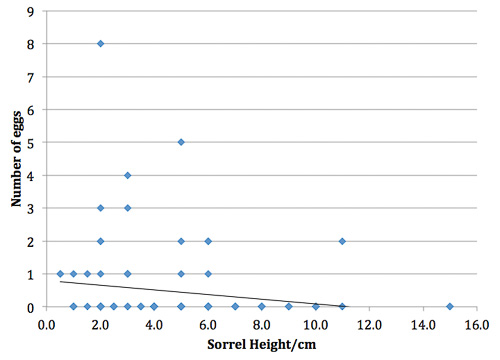 |
| Figure 12 - How the height of a Sorrel affects the number of Small Copper eggs laid on it |
Here, the r value is -0.0342, indicating the weakest of negative correlations, to the point where there is no significant relationship between the two variables, yet when I put the Sorrel heights into categories and calculated the percentage of plants of each category with eggs, it became clear that there was a correlation between the two, with an r value of -0.6789. It was for this reason, 'cutting through the fog' of zero values, that I chose to use percentages and categories to show my data.
There is, however, an issue with percentages, in that extreme values can skew the percentage you generate when you have a small sample size. For example, I found only 3 Sorrels of height 11cm, but one of these had eggs on, this would generate a value of 33% of 11cm plants having eggs, suggesting that female Small Coppers have a real liking for plants of this type. This conclusion could easily be made from the percentage generated, but it would be rash to do so, since the high percentage results from the skew caused by one unusual result in a small sample. As such, I had to be careful when analysing my data and drawing conclusions, making sure to eliminate anomalous results (such as the one mentioned above), since percentages can paint a picture that is not an accurate reflection of the data. Despite my caution, I feel my use of categories (which often contained very few plants) and percentages (with their potential to be skewed), somewhat limits the reliability of my findings given the small sample size.
Another limitation I found in my analysis was when attempting to disprove the null hypothesis, and prove correlations in my data. Here, I opted to use the product moment correlation coefficient (generating an 'r value' of correlation), since I am familiar with the use of this statistical test through the statistics module of my AS Level maths course. Further reflection has, however, suggested that this is not the best possible statistical test for grouped data, it being better for scatter graphs.
I would like to thank the following for their kind help during the course of my project: Pete Eeles for his invaluable advice on rearing Small Coppers, and his and Mark Colvin's instructive comments on my write-up and Dr. Anna Jolliffe for her support and advice throughout.